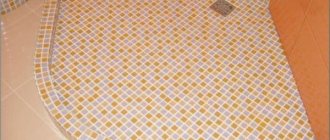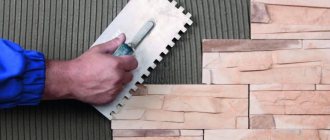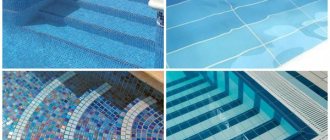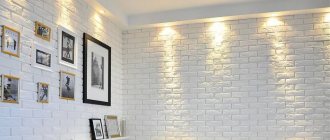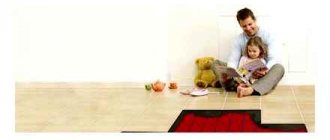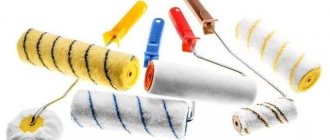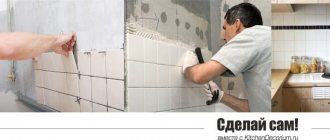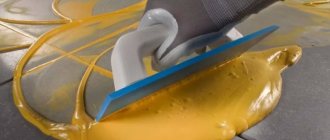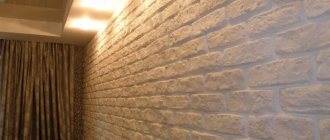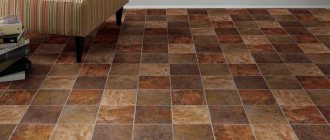Bathrooms are rooms filled with various communications (plumbing, electrical, sewerage, ventilation) and devices (meters). To repair them, unobstructed access is required, which can be provided by special bathroom hatches under tiles, and their sizes are selected according to the dimensions of the hidden niche, and the material is selected according to the owner’s preference. In addition, inspection holes are useful for storing cosmetics, cleaning devices, and washing plumbing fixtures. To make a choice, you need to understand the existing types of hatches, since they serve specific purposes and have different sizes for each bathroom and toilet object.
Structural elements
The type of hatch depends on its design features. Wall options consist of the following elements:
- frame (plastic, aluminum);
- lock;
- loops;
- sash.
Hatch elements
Scheme of a rubber hatch-clip
A plumbing hidden door for a sanitary room is made of moisture-resistant material or treated with special waterproof materials, for example, drywall is coated with a moisture-proof emulsion.
The method of opening and closing the sash depends on the hinge mechanism. The simplest option is hinged hinges, the complex one is double hinges with additional adjustment units.
Scheme of the hatch frame structure
Inspection frames are mounted in two ways (liquid nails, self-tapping screws) into a niche or wall. The lock can be roller or push. In one case or another, it is hidden.
Rational installation of the inspection hatch
The inspection hatch is a device made of frame binding and one or two sashes. The product is intended to mask a technological opening, which is formed to provide open access to node connections, shut-off valves, and metering devices in the system of certain utilities. In this case, the networks are mounted according to a hidden principle in niches of structures or behind cladding materials or separate boxes.
The convenience of installing inspection hatches is that for preventive inspection of communications, repairs or taking readings from metering equipment, it is not necessary to violate the integrity of structures and decorative finishes. There are several varieties of finished products that do not require additional decoration. This does not exclude the possibility of using lightweight covering or painting materials. Another group of devices is intended for subsequent cladding with tiles, panels, lining and other samples that fit into the overall interior of a particular room.
Masking the technological opening against the background of the general cladding Source prom.st
Types of hatches by purpose
Inspection devices are intended to eliminate technical problems in various communications, according to this they are divided into the following types:
- plumbing (plastic, metal) - designed to hide and maintain devices and communications;
- electrical - provide easy access to wiring, sockets, lighting. They may also have a hidden type of operation;
- ventilation - designed for servicing the ventilation system (filters, pipes). They have a perforated door through which air flows, as well as free access for repair and maintenance of the line.
Purpose and scope of use
The main problem of bathrooms is the concentration of all known household communications and appliances in these small rooms:
- risers and cold water/hot water circuits;
- sewerage system;
- wiring;
- cold and hot water meters;
- filtration equipment;
- distribution manifold of the heated floor system;
- shut-off valves.
In the stylistic design of bathroom interiors, urban and high-tech engineering systems can somehow be played up. In all other cases, the owner prefers to disguise communications with boxes and false panels under a layer of decorative tiles and porcelain stoneware.
However, a new problem arises - access must be provided to pipes, meters, taps, filters, water seals of siphons of sinks, showers, bathtubs, and toilet cisterns. Therefore, in gypsum plasterboard/gypsum plasterboard systems, an opening is left and a hatch is installed under a metal bathtub for subsequent finishing with tiles, mosaics in the same style as the entire wall, or screen.
Hatches to the bathtub at the installation site
Depending on the installation location, wells for the full operation of plumbing fixtures are divided into the following types:
- ceiling - most often installed in a suspended ceiling made of plasterboard or chipboard. When choosing it, you should be guided by such parameters as lightness (so that the door does not open spontaneously under its own weight) and strength;
- wall-mounted - inspection devices of this type are the most common in everyday use. There is a wide range of plastic, metal and combined ones. Size, color and the possibility of finishing under the wall when choosing are not a problem;
- floor - such windows are equipped to service utilities located below floor level, for example, a cellar or basement. Their sizes can reach impressive dimensions to ensure free entry and exit for the owner.
Floor inspection hatch
Wall hatches
Roof hatch
Pipe networks
Any engineering systems in a house or apartment are designed to carry out inspections of plumbing, heating and sewerage equipment. Most often they can be found in a round shape, but square modifications are also made for paths made of paving slabs.
Various raw materials are used for their production:
- Plastic;
- Cast iron;
- Polymer sand.
Hatches made from materials such as plastic and polymer sand are used primarily for sidewalk structures, park alleys, etc.
This is due to the fact that this raw material is not able to withstand too heavy loads (no more than one and a half tons). It also doesn't cost much in terms of cost.
Typically, inspection devices made of plastic last about 50 years, and those made of polymer sand - at least 20 years. These materials are particularly resistant to temperature conditions - from minus sixty to plus sixty degrees Celsius. Among the models produced, you can notice a variety of colors.
Benefits of using hatches
Even the simplest hatch has the following advantages:
- integrity of the tile - if installed correctly, there is no need to adjust the size of the tile. Experts advise you to adhere to this particular technology when finishing walls;
- sizes in a wide range (in the case of a rectangular shape - from 0.20 to 1.5 m). The option of individual production is also possible, but in this case the price will increase several times;
- the possibility of using larger tiles than the door itself;
- unity of design - the door is subject to various types of finishing (even with heavy materials), which makes it invisible in the bathroom;
- ease of installation - you do not need to have certain skills to carry out independent installation.
Peculiarities
Once the type of inspection hatch is determined, it is worth choosing any model, looking at the sizes of the tiles and equipment that needs to be hidden.
- If tiles are used for finishing, take into account that the plate does not extend beyond 5 to 70 mm.
- The dimensions of the hatch installed under the bathroom are 20 by 20 cm, then the door that will be on top of the hatch is 300 by 300 mm.
To choose the right hatch for your bathtub, you should carefully consider the features of hatch models from different manufacturers.
When choosing, they look at the brand, materials and, of course, how the doors open. Take into account how the canopies are located, for example, the size of 300 by 200 mm at the hatch should have hinges on the short sides.
Types of hatches by design
When choosing, pay attention not only to the purpose of the hatch and its installation option, but also to the design features. Check out what a bathroom hatch can look like under tiles, and find out which option is more convenient for you. Opening and closing the door is carried out using different mechanisms and, according to this, they are divided into the following types:
- hinged - they are usually made of metal so that they can be opened using rubber or plastic suction cups. The mechanism involves pushing the sash forward, and then opening. But you can find plastic products on sale;
- under tiles - they have a swing mechanism (like an interior door). They are distinguished by ease of installation, low cost, wide selection of installed accessories (push lock, handles);
- sliding - the design is more complex compared to previous types. Suction cups are used to open and close. First, the sash is pulled forward, then moved in any direction. This structural element is necessary if access to communications is limited by furniture or household appliances. In order not to look for suction cups throughout the bathroom, you can use a push or roller mechanism to quickly open the door;
- push - by pressing a finger on the tile, the door device of this type of hatch is activated, moving forward and swinging open. The push mechanism is perfect for installation in a bathroom, which is finished not with tiles, but with mechanically unstable materials, for example, mosaic panels;
- on magnets - neodymium magnet is often used in the manufacture of floor and wall viewing windows. Its main advantage is that it can withstand heavy weight. They are made invisible, compared to push ones, by a clever design technology: a smaller groove for the hatch so that the sash is under the cladding, for example, tiles. If the window is large and heavy, the door is equipped with a convenient handle. Small lids are most often made hinged. In floor-standing versions, the magnet serves as an additional element to add weight to the lid. In the wall-mounted version, the door slides to the side.
Magnetic hatch
Push hatch
Hinged hatch
Sliding sunroof
Opening mechanisms
Manufacturers install the following door opening mechanisms:
- swing;
- push;
- folding;
- sliding
Each type of opening has its own advantages. When choosing, you should focus on ease of use.
Image gallery
Photo from
Swing door opening mechanism
Invisibility hatch with push mechanism
Sliding mechanism with three-link hinges
Hinged hatch for hard to reach areas
It is hardly possible to come up with a more convenient opening mechanism than a hinged one. However, an audit is often needed where access is difficult due to equipment or furniture. Then folding and sliding models come to the rescue.
If there is space on at least one side, then it is better to choose a sliding mechanism. And for areas with difficult access, folding structures with the ability to completely remove the door are more suitable.
We distinguish inspection windows by material
For ease of use and decoration of the bathtub, the inspection well is made from various materials. The most popular in the construction market are:
- plastic ones are the most cost-effective option for providing access to hidden communications and meters. The design of the doors is no different from each other (neutral white plastic), but the sizes are presented in a wide range. The smallest windows are 10x10 cm, the largest are 80x50 cm. These sizes are quite sufficient to inspect meter readings or repair any unit or pipes. Plastic devices are easy to install. It is enough to plant it on a pre-prepared place with liquid nails or screw in self-tapping screws. The opening mechanism - push - is pressed on the lower corner of the sash, after which it swings open;
- metal - the design is very similar to plastic products, only they are made of metal. The size parameters and installation method are also identical to the plastic product. A distinctive feature is its operational properties - long service life and attractive appearance for a long time. The downside is their price.
Metal hatch
Plastic hatch
Metal viewing windows are used mainly as an invisible one, since they have more weight compared to plastic ones. They finish it with the same material as the bathroom wall so that the structural element does not stand out from the overall picture. In addition, the hatch can be installed not only to provide access to communications, but also to store various cosmetics and cleaning products for cleaning. To install an invisible well, you need to work harder than in the case of a visible one. The first stage is the installation of the inspection element, the second is finishing the wall.
If funds do not allow you to purchase a hatch or there are other reasons (non-standard shape, size), then you can make it yourself from available materials, for example, from plasterboard or chipboard. These materials easily accept masking coatings. To increase operation, it is recommended to make the frame from metal.
Features of installation of inspection hatches under tiles
Before installing an inspection hatch under a tile or a finished sample, it is necessary to correctly form the technological opening. A reliable support base made of wooden beams, boards or metal profiles is assembled under the supporting frame. The exception is the block design. Here you may need additional leveling of the side walls with durable cement plaster.
Installing a hatch on a metal profile frame before covering the walls with plasterboard Source cstor.nn2.ru
The next step is to install the main frame. Here it is more convenient to complete the task after removing the sash from the binding. It is important to carefully adjust the position of the “box” taking into account the horizontal and vertical levels. If the diagonals between opposite corners are different, then the door will not fit freely into the opening, and the fittings and door leaf will quickly fail. The frame for loaded doors must also be aligned in the longitudinal plane to prevent damage to the decorative finish and control mechanisms.
Plastic hatches are often fixed with liquid nails. Craftsmen recommend not focusing on the lightness of finished products. For any model, the “box” must be additionally secured with self-tapping screws, and, if necessary, with dowel nails. After this, you can assemble the structure and check the entire installation for correctness.
How to calculate the size
Rules by which you can calculate sizes:
- decide on the installation location. Usually this is a pipe junction unit, meters, ventilation pipes;
- we measure the tiles (height, width) that will be used to finish the bathroom walls;
- we calculate the number of tiles in order to close the well;
- We calculate the height and width of the sash. The number of horizontal tiles counted is multiplied by the width of one unit of finishing material. This is how the width of the viewing window is calculated. Such calculations are used to determine height. But the dimensions of the viewing window will be slightly larger.
| Door dimensions, mm width x height | Dimensions of the door window on the outside, mm Width x height x depth |
| 155x244 | 200x300x50 |
| 255x244 | 300x300x50 |
| 255x344 | 300x400x50 |
| 255x444 | 300x500x50 |
| 255x544 | 300x600x50 |
| 355x244 | 400x300x50 |
| 355x344 | 400x400x50 |
| 355x444 | 400x500x50 |
| 355x544 | 400x600x50 |
| 355x694 | 400x750x50 |
| 355x844 | 400x900x50 |
| 455x444 | 500x500x50 |
| 455x544 | 500x600x50 |
| 455x744 | 500x800x50 |
| 555x344 | 600x400x50 |
| 555x544 | 600x600x50 |
| 555x844 | 600x900x50 |
| 555x944 | 600x1000x50 |
During the calculation, the protrusion of the tile beyond the lid is taken into account. It should be no less than 0.5 cm on the side where the loops are located and no more than 5 cm on all other sides.
When deciding on the size of the hatch, you need to strive to ensure that the whole amount of facing material fits on it. Otherwise, it will not be possible to hide his presence from the overall picture.
There are viewing windows on sale whose design has a movable mechanism, that is, during installation it is possible to adjust the size. If after installation excess structural elements appear, they are cut off with a grinder. The location of communications may be different and in some cases it is better to install several small hatches that fit perfectly into the size of one tile.
Review of manufacturers
It is very important, when compiling reviews, to talk about different manufacturers of the products being described. Knowing which ones you can trust makes purchasing ready-made hatches much easier.
When compiling an impromptu ranking, I wanted to determine first place. This company produces aluminum pressure products called “Slava”. They are very popular in the domestic market. And that's why:
- The hatch door opens with a light press without the additional use of any devices (hooks, for example). All fittings are made in Germany. The door extends completely out of the housing, so it does not impede access to existing utilities.
- The door is attached to the base of the body using a self-centering hinge. It is able to withstand high loads, while centering the hatch cover in relation to the body opening. That is why, during numerous openings of the product, the tiles glued to the lid will not chip or crack.
- When closed, the inspection hatch is a completely sealed product.
- Products undergo four-stage quality control.
- The manufacturer provides a five-year warranty on all its products.
- The design of the hatch is such that the door can withstand heavy loads. Therefore, any facing materials can be overlapped on the door.
- There is a rubber seal on the body. When the hatch is closed, it fully performs the function of reliable waterproofing. Therefore, the described product can be used in rooms with high humidity.
- The Slava hatch can be installed in any wall (the product can be fixed to a plasterboard base, or to brick or concrete walls).
A generalization of the described technical features of Slava brand products allows us to say that there are undeniable advantages.
Reliable hatches for Praktika tiles take second place in the proposed rating. Their installation involves the use of any tiled facing material: from ordinary ceramics to heavy porcelain stoneware slabs or natural marble. The main advantage of this product is the reinforced housing. It is made of thick-walled steel pipe, so the frame can withstand any load. Experts recommend choosing such products when you need to choose a floor-standing option.
The third place in popularity of models is occupied by hatches for Euroformat tiles. These are lightweight structures, they are lightweight, made of durable aluminum, and are used for installation in plasterboard niches. The mounted structure creates virtually no additional load on the false walls.
How to choose the position of the viewing window and its opening side
The location for the inspection well is determined in accordance with the location of other items in the bathroom. It is also necessary to provide for installation with the necessary viewing angle convenient for the user. Experts recommend opening the door from left to right, but vertical swinging requires a large space. Avoid installing the sash close to the floor, otherwise the lower edge may cause mechanical damage to the coating. The angular position of the hatch is not rational for two reasons: weak design, inconvenient door location.
Generalization on the topic
When making your choice in favor of one option or another, it is important to take into account several factors at once: where the product will be installed, what door design will be able to provide unhindered access to utilities, what size access is needed, which manufacturer is trusted.
Despite the fact that in the line of products presented, each manufacturer produces hatches of different sizes, almost all offer the service of making custom-made products. This possibility must be taken into account if there is a need to quite clearly adjust the dimensions of the valves to the already completed inspection opening. This solution makes it possible to provide convenient access to pipes, water meters, and other utilities on the one hand, and on the other, to make this access as inconspicuous as possible. Which is very important for modern stylistic concepts of decor.
Which hinge is better: steel or aluminum
Quite often, buyers argue among themselves about which hinge material is better - aluminum or steel. To obtain the most detailed answer, products from four popular manufacturers were tested. The maximum load that the hatch hinge can handle in the event of a uniform increase in the load on the open door was tested.
It turned out that the aluminum alloy cracked under a load of 600 kilograms, and the steel hinges were bent to such an extent that they could not be straightened in order to close the hatch. We can conclude that there is no difference between the type of material - it all depends on the preferences of the buyer.
Pressure hatches what to look for
Hatches that open with a suction cup are becoming less and less relevant every year, as push locks are used instead. Although push locks reliably hide everything behind the door, if they are blocked or removed, you can still use the suction cup.
Before purchasing a lock, you need to pay attention to the groups of locks, there are only two of them: Combitach and furniture locks. Both options are equally suitable for bathrooms and other rooms with high humidity levels. Although Combitach is more expensive, these locks were designed specifically for hatches. At the same time, they can be opened by hand as easily as possible.
Hinged sliding and removable doors: which ones to choose
Most often, apartment owners prefer to install technological hatches equipped with hinged doors. The specific design of the hinge makes it possible to open the door parallel to the wall, and only then swing it open. The result is the ability to fix tiles whose dimensions exceed the size of the door.
The hatch, equipped with sliding doors, has a three-link hinge. This solution is relevant in conditions of limited space, when, for example, it is necessary to open a hatch under large plumbing fixtures - for example, a bathtub.
Models with removable doors are characterized by simplicity of design. It consists of a door for decoration with tiles and an aluminum frame. Push locks are responsible for holding the door.
Adjusting the hatch: what solutions can there be and what are their features
The design of the installed hatch has a large number of moving parts that wear out rapidly, especially if tiles are glued to the front covering of the door. The spatial loop begins to loosen over time.
Sagging causes decorative tiles to chip when closing and opening the hatch. Also, seams may become uneven around the perimeter and in the layout.
To restore full operation of the hatch, it is necessary to adjust it horizontally and vertically. In addition, it is necessary to set the angle of inclination of the door relative to the general surface.

